Bibliography Background About KRIS
Fish Populations in Gulf of Maine Rivers and Lakes
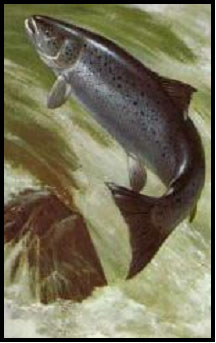 Atlantic salmon (Salmon salar) native to the Gulf of Maine were once a mainstay of regional diet and trade, with the Penobscot River alone estimated to support more than 100,000 adults annually (Baum, 1997). Other native fishes thrived in the area and were also important commercially. Baum (1997) reports astounding catches:
Atlantic salmon (Salmon salar) native to the Gulf of Maine were once a mainstay of regional diet and trade, with the Penobscot River alone estimated to support more than 100,000 adults annually (Baum, 1997). Other native fishes thrived in the area and were also important commercially. Baum (1997) reports astounding catches:
"In June 1807 it was reported that 7,000 striped bass, ranging from 10 to 60 pounds in weight, were taken at the mouth of the Kenduskeag Stream in Bangor. Another report from mid-May 1812 reported that one haul of the seine by Mr. Luther Eaton of Eddington took 7,000 shad and 100 barrels of alewives."
Although commercial fishing for Atlantic salmon began as early as 1628, stocks were so robust that no regulation took place until 1867, although "declining fish stocks in the major rives of the State had been a topic of concern for the first half of the nineteenth century" (Baum, 1997). The advent of dams in the 1800's was a major blow to Atlantic salmon populations, as well as to other migratory native fishes, but despite the greatly diminished rearing habitat, fisheries continued.
Atlantic salmon, through homing, evolve into distinct populations adapted to local conditions with inherited characteristics including "growth rate, resistance to disease, ocean migration patterns and timing of return to the river and area of spawning" (Mills, 1991). United States Atlantic salmon are genetically distinct from those of neighboring Canada and further divergent from those of Iceland and Europe (Baum, 1997; NRC,2002). The Gulf of Maine Atlantic salmon have been recognized as a distinct population segment (DPS) and seven native river stocks have been identified for protection under the Endangered Species Act (ESA) (USFWS and NOAA. 2000). These rivers are listed in Table 1 along with watershed area, fish habitat summary and goals for Atlantic salmon fisheries from the Atlantic Salmon Conservation Plan for Seven Main Rivers (MASTF, 1997). The Penobscot River, Kennebec River and Togue Stream are also under consideration for protection under ESA, but there is some question as to whether the latter populations have been too influenced by hatchery operations to be considered wild stocks. Other Atlantic salmon stocks that once returned to rivers as far south as Connecticut have gone extinct, although populations in the Connecticut River and a few others are being revived using hatcheries.
Table 1. From MASTF (1997): Atlantic salmon management goals for seven Gulf of Maine rivers.
| River | Area (mi2) | Habitat (100m2) | Smolt Production Goals1 | Minimum Spawning | Recreational Harvest Goal | Minimum Total Run |
| Dennys | 132 | 2,415 | 7,245 | 161 | 75 | 236 |
| East Machias | 251 | 2,145 | 6,435 | 143 | 50 | 193 |
| Machias | 460 | 6,685 | 20,055 | 446 | 150 | 596 |
| Pleasant | 85 | 1,085 | 3,255 | 72 | 25 | 97 |
| Narraguagus | 232 | 6,015 | 18,045 | 401 | 100 | 501 |
| Ducktrap | 36 | 585 | 1,755 | 39 | 20 | 59 |
| Sheepscot | 226 | 2,845 | 8,535 | 190 | 25 | 215 |
| Total | 1,422 | 21,775 | 65,325 | 1,452 | 445 | 1,897 |
1 Based on egg deposition of 2.4 eggs/sq.meter of habitat, 7,200 eggs/female, 50/50 sex ratio, and 3.0 smolts per habitat unit.
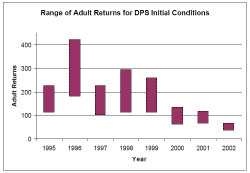 The Gulf of Maine DPS Atlantic salmon populations have dropped to extremely low levels in recent years (Kircheis, 2001; 2002). For example, three rivers were thought to have no returns in 2002, while the combined estimated returns to the other four rivers were 23 to 46 adult salmon. (Kircheis, 2002). The chart at left shows the range of estimated returns of Atlantic salmon to the seven rivers recognized as the distinct population segment (DPS) from the Gulf of Maine for 1995 to 2002 from Legault (2004). Returns have trended downward with estimates ranging from the low hundreds to just a few dozen adults in 2002.
The Gulf of Maine DPS Atlantic salmon populations have dropped to extremely low levels in recent years (Kircheis, 2001; 2002). For example, three rivers were thought to have no returns in 2002, while the combined estimated returns to the other four rivers were 23 to 46 adult salmon. (Kircheis, 2002). The chart at left shows the range of estimated returns of Atlantic salmon to the seven rivers recognized as the distinct population segment (DPS) from the Gulf of Maine for 1995 to 2002 from Legault (2004). Returns have trended downward with estimates ranging from the low hundreds to just a few dozen adults in 2002.
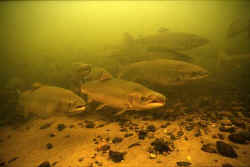 Adult Atlantic salmon often move into lower river reaches in spring and early summer to stage for their spawning migrations. They may move upstream several miles early in the season then return to the estuary (Baum, 1997). Adults and grilse move in and out with large tidal cycles, onshore winds and freshets (Mills, 1991). Atlantic salmon are excellent leapers and may ascend waterfalls to spawn in headwater tributaries. They seek gravels 20-30 cm (Crisp and Carling, 1989), which are relatively free of sand and fine sediment (Moir et al., 1998), although in larger streams they may choose substrate as large as 100 mm (Heggberget, 1991). While 70-90% of adults in larger rivers, such as the Machias and Narraguagus, enter the river by August, smaller rivers like the Sheepscot may have more than 50% returning after September with fall rains (Baum, 1997). Spawning takes place from mid-October to late November (Danie et al., 1984). Armstrong et al. (2003) studied the life history requirements of Atlantic salmon by life stage, separating out spawning, nursery and older parr rearing requirements (Table) following the convention of Heggenes (1999).
Adult Atlantic salmon often move into lower river reaches in spring and early summer to stage for their spawning migrations. They may move upstream several miles early in the season then return to the estuary (Baum, 1997). Adults and grilse move in and out with large tidal cycles, onshore winds and freshets (Mills, 1991). Atlantic salmon are excellent leapers and may ascend waterfalls to spawn in headwater tributaries. They seek gravels 20-30 cm (Crisp and Carling, 1989), which are relatively free of sand and fine sediment (Moir et al., 1998), although in larger streams they may choose substrate as large as 100 mm (Heggberget, 1991). While 70-90% of adults in larger rivers, such as the Machias and Narraguagus, enter the river by August, smaller rivers like the Sheepscot may have more than 50% returning after September with fall rains (Baum, 1997). Spawning takes place from mid-October to late November (Danie et al., 1984). Armstrong et al. (2003) studied the life history requirements of Atlantic salmon by life stage, separating out spawning, nursery and older parr rearing requirements (Table) following the convention of Heggenes (1999).
 Young of the year Atlantic salmon come out of the redd and often disperse only a short distance, preferring lower water velocities and shallow depths (Armstrong et al., 2003). Older parr seek out deeper water and prefer stations with boulders or cobble because they can move down into interstitial spaces to avoid predation. During winter, juvenile Atlantic salmon may actually move down into the substrate of the stream bed when water temperatures drop (Heggenes, 1990). Atlantic salmon of Maine generally spend two years in fresh water and two years in the ocean environment (Baum, 1997). If lakes are available as rearing habitat, parr may adopt a lacustrine life history (Einarsson et al., 1990). The NAS (2004) noted significant problems in mortality of smolts and post-smolts just after ocean entry and advanced the hypothesis that acid runoff was a causal mechanism. This is a greater concern in Downeast rivers where the geology and soils provide less buffer capacity than in rivers south of the Penobscot (see KRIS Sheepscot pH data).
Young of the year Atlantic salmon come out of the redd and often disperse only a short distance, preferring lower water velocities and shallow depths (Armstrong et al., 2003). Older parr seek out deeper water and prefer stations with boulders or cobble because they can move down into interstitial spaces to avoid predation. During winter, juvenile Atlantic salmon may actually move down into the substrate of the stream bed when water temperatures drop (Heggenes, 1990). Atlantic salmon of Maine generally spend two years in fresh water and two years in the ocean environment (Baum, 1997). If lakes are available as rearing habitat, parr may adopt a lacustrine life history (Einarsson et al., 1990). The NAS (2004) noted significant problems in mortality of smolts and post-smolts just after ocean entry and advanced the hypothesis that acid runoff was a causal mechanism. This is a greater concern in Downeast rivers where the geology and soils provide less buffer capacity than in rivers south of the Penobscot (see KRIS Sheepscot pH data).
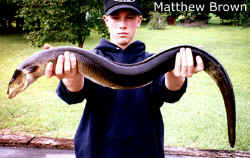 Meister (1982) listed the resident and anadromous fish species of the Sheepscot basin, which is a representative Gulf of Maine river. Native species are listed in Table 2. There are more than two dozen species and a dozen are anadromous or catadromous, spending part of their lives in both fresh and salt water. The American eel is catadromous, which means it spawns in the sea and returns to freshwater streams to rear. It is often called the silver eel because it changes color to silver, similar to the salmon, when it enters the ocean for its spawning journey. The eastern brook trout is a resident species throughout Maine, but may also sometimes adopt a sea run life history.
Meister (1982) listed the resident and anadromous fish species of the Sheepscot basin, which is a representative Gulf of Maine river. Native species are listed in Table 2. There are more than two dozen species and a dozen are anadromous or catadromous, spending part of their lives in both fresh and salt water. The American eel is catadromous, which means it spawns in the sea and returns to freshwater streams to rear. It is often called the silver eel because it changes color to silver, similar to the salmon, when it enters the ocean for its spawning journey. The eastern brook trout is a resident species throughout Maine, but may also sometimes adopt a sea run life history.
 The shortnose sturgeon is a native to the larger rivers of the coast and like the Atlantic salmon is recognized as a distinct population (NMFS, 1998). The closely related American shad, blueback herring and alewife are other anadromous species. Meister and Foye (1963) noted that rivers like the Sheepscot historically had large runs of shad but that dams had restricted their numbers because they were less able to move past barriers than alewives. Striped bass remain an important anadromous sport fish regionally. Although introduction of the sea lamprey has caused great problems with fisheries in the Great Lakes, it is a part of the native fish community in the Gulf of Maine and should be valued for its ecological role (Kircheis, 2004)
The shortnose sturgeon is a native to the larger rivers of the coast and like the Atlantic salmon is recognized as a distinct population (NMFS, 1998). The closely related American shad, blueback herring and alewife are other anadromous species. Meister and Foye (1963) noted that rivers like the Sheepscot historically had large runs of shad but that dams had restricted their numbers because they were less able to move past barriers than alewives. Striped bass remain an important anadromous sport fish regionally. Although introduction of the sea lamprey has caused great problems with fisheries in the Great Lakes, it is a part of the native fish community in the Gulf of Maine and should be valued for its ecological role (Kircheis, 2004)
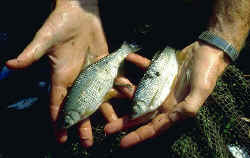 The freshwater fish fauna in the rivers and lakes of the Gulf of Maine is quite diverse, with a number of families represented. A myriad of species thrive in the glacially formed lakes that dot the landscape. The lake trout, or Togue, is a salmonid family member that inhabits Gulf of Maine lakes. Native fishes in coastal Maine rivers include sunfish (pumpkinseed and redbreast sunfish), catfish (brown bullhead), minnows (golden shiner, common shiner, fallfish) and perch (yellow and white). Individual species represent other families such as the white sucker and swamp darter. The range of many resident species of Maine coastal rivers extends from Nova Scotia to the Mid-Atlantic, although the range of some species extends as far south as Florida, and the golden shiner is present around the Gulf of Mexico to southern Texas (Frose and Paulie, 2004).
The freshwater fish fauna in the rivers and lakes of the Gulf of Maine is quite diverse, with a number of families represented. A myriad of species thrive in the glacially formed lakes that dot the landscape. The lake trout, or Togue, is a salmonid family member that inhabits Gulf of Maine lakes. Native fishes in coastal Maine rivers include sunfish (pumpkinseed and redbreast sunfish), catfish (brown bullhead), minnows (golden shiner, common shiner, fallfish) and perch (yellow and white). Individual species represent other families such as the white sucker and swamp darter. The range of many resident species of Maine coastal rivers extends from Nova Scotia to the Mid-Atlantic, although the range of some species extends as far south as Florida, and the golden shiner is present around the Gulf of Mexico to southern Texas (Frose and Paulie, 2004).
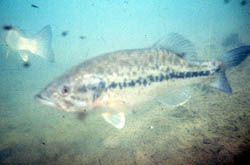 Introduction of exotic fish species is a recognized threat to Gulf of Maine Atlantic salmon streams. Largemouth bass, smallmouth bass, brown trout and chain pickerel are all significant predators of salmon. Meister (1982) noted that dead water areas and pools in lower rivers were habitats where chain pickerel and large mouth bass could ambush migrating Atlantic salmon juveniles or smolts. Those juvenile salmon migrating through lakes would also be susceptible. Although the pickerel is native to the interior of Maine, it was introduced to coastal rivers. See the Maine Department of Inland Fisheries and Wildlife web page on exotic species to learn more about how illegal fish stockings threaten native fish.
Introduction of exotic fish species is a recognized threat to Gulf of Maine Atlantic salmon streams. Largemouth bass, smallmouth bass, brown trout and chain pickerel are all significant predators of salmon. Meister (1982) noted that dead water areas and pools in lower rivers were habitats where chain pickerel and large mouth bass could ambush migrating Atlantic salmon juveniles or smolts. Those juvenile salmon migrating through lakes would also be susceptible. Although the pickerel is native to the interior of Maine, it was introduced to coastal rivers. See the Maine Department of Inland Fisheries and Wildlife web page on exotic species to learn more about how illegal fish stockings threaten native fish.
References
Armstrong, J. D., P. S. Kemp, G.J. Kennedy, M. Ladle and N.J. Milner. 2003. "Habitat requirements of Atlantic salmon and brown trout in rivers and streams." Fisheries Research. 62(2): 143-170.
Baum, E. (1997). Maine Atlantic Salmon: A National Treasure. Hermon, ME:, Atlantic Salmon Unlimited. 224 p.
Bryant, F.G. 1956. Stream Survey of the Sheepscot and Ducktrap River Systems in Maine. USDOI, U.S. Fish and Wildlife Service, Washington D.C. Special Scientific Report: --Fisheries No. 195. 22 p.
National Research Council. 2002. Genetic status of Atlantic salmon in Maine: Interim Report. National Academy Press Washington, D.C.. http://www.nap.edu/books/0309083117/html/
Crisp, D.T. and Carling, P., 1989. Observations on siting, dimensions and structure of salmonid redds. J. Fish Biol. 34, 119–134.
Danie, D.S., J. G. Trial, and J. G. Stanley. 1984. Species profiles: life histories and environmental requirements of coastal fish and invertebrates (North Atlantic) -- Atlantic salmon. U.S. Fish Wildlife Service.. FWVOBS-82/11.22. U.S. Army Corps of Engineers, TR EL-82-4. 19 pp. [500kb]
Einarsson, S.M., Mills, D.H., Johannsson, V., 1990. Utilisation of fluvial and lacustrine habitat by anadromous Atlantic salmon, Salmo salar L., in an Icelandic watershed. Fish. Res. 10, 53–71. 107 (5), 703–712.
Froese, R. and D. Pauly. Editors. 2004. FishBase. World Wide Web electronic publication. www.fishbase.org. Version (03/2004).
Heggberget, T.G., 1991. Some environmental requirements of Atlantic salmon. Am. Fish. Soc. Symp. 10, 132–135.
Heggenes, J. 1990. Habitat utilisation and preferences in juvenile Atlantic salmon (Salmo salar) in streams. Regul. Rivers 5, 341–354.
Kircheis, F.W., 2001. Annual Report to the Maine Legislature Fish and Wildlife Committee for the period January through December 2001. Maine Atlantic Salmon Commission, August, Maine. 59 p. [1.4 Mb]
Kircheis, F.W., 2002. Annual Report to the Maine Legislature Fish and Wildlife Committee for the period January through December 2002. Maine Atlantic Salmon Commission, August, Maine. 73 p. [2.4 Mb]
Kircheis, F.W. 2004. Sea Lamprey: Petromyzon marinus. Prepared by: F.W. Kircheis L.L.C., RR #3 Box 1488, Carmel, Maine 04419. [1.5 Mb]
Legault, C.M. 2004. A Population Viability Analysis Model for Atlantic Salmon in the Maine Distinct Population Segment. National Oceanic and Atmospheric Administration, Northeast Fisheries Science Center, Orono, ME. Reference Document 04-02. 98 p. [725kb]
Maine Atlantic Salmon Task Force (MASTF). 1997. Atlantic Salmon Conservation Plan for Seven Maine Rivers. Task Force appointed by the Governor of Maine. 353 p. [1.6Mb]
Mills, D. 1991. Ecology and Management of Atlantic salmon. Chapman and Hall, University Press, Cambridge, U.K. 351 p.
Meister, A.L. and R.E. Foye. 1963. Sheepscot River Drainage Fish Management and Restoration. Atlantic Sea Run salmon Commission and the Maine Department of Inland Fisheries and Game. 35 p. Note Document will be available in the final KRIS Sheepscot.
Meister., A.L. 1982. The Sheepscot River: An Atlantic Salmon River Management Report. Atlantic Sea Run Salmon Commission, Bangor, Maine. [3.7Mb]
Moir, H.J., Soulsby, C., Youngson, A., 1998. Hydraulic and sedimentary characteristics of habitat utilized by Atlantic salmon for spawning in the Girnock Burn, Scotland. Fish. Man. Ecol. 5, 241–254.
National Marine Fisheries Service. 1998. Final Recovery Plan for the Shortnose Sturgeon (Acipenser brevirostrum). Prepared by the Shortnose Sturgeon Recovery Team for the DOC National Oceanic and Atmospheric Administration, Washington D.C. 129 p. [250kb]
National Research Council. 2003. Atlantic Salmon in Maine. Committee on Atlantic Salmon of Maine, National Research Council, National Academy of Sciences, National Academy Press, Washington D.C. [3.5Mb]
USFWS and NOAA. 2000. Endangered and Threatened Species; Final Endangered Status for a Distinct Population Segment of Anadromous Atlantic Salmon ( Salmo salar) in the Gulf of Maine. Federal Register Notice Vol. 65, No. 223 / Friday, November 17, 2000 / Rules and Regulations. Pages 69459-69483. [225kb]
